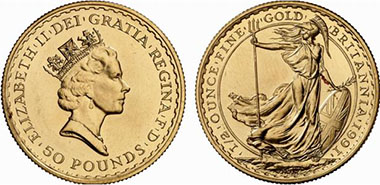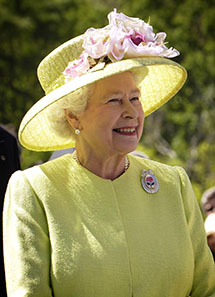by Björn Schöpe
courtesy of Barbara Balz / World Money Fair
Resolutely, Britannia is leaning against the wind. Her trident is reminiscent of Poseidon, god of the sea, and on her shield is the national banner. In her hand, she is holding a laurel branch, telling of victory.
Elizabeth II (since 1952). 50 pounds 1991, London. From Künker auction 139 (2008), 7606.
This image of Britain’s personification stems from an old tradition, and today it invokes a glorious past. Elizabeth II is the current Queen of the United Kingdom, the latest in a long line of impressive figures. In over half a century, she has lived through a lot of history, although, after all, she hasn’t had much influence: As Queen, she is at the head of a constitutional monarchy with a democratic government.
At first, it did not seem so probable that the young girl would one day ascend to the throne. Her uncle was the new king, and his children would follow him. But Edward VIII wished to marry a divorced American and therefore abdicated. Thus, it was Elizabeth’s father who was at the centre of attention when World War II began. In 1940, when German bombers were heading for London, the 14-year-old princess spoke on the radio to comfort the children who had been evacuated. At the age of 18, she insisted on joining the military, where she learned to drive, and trained as a mechanic and motorist. She has maintained this sense of duty toward her country during all her life. In 1952, Elizabeth succeeded her father on the throne.
Soon afterwards, the United Kingdom had to renounce on half of its empire: Countries like Ceylon, India or South Africa became independent republics. The rest of the empire remained loyal to Britannia, reconstituting itself in a Commonwealth of Nations.
In the Commonwealth states, Elizabeth remains the official head of state and, as such, her portrait is on all coins. As the highest representative of the United Kingdom, she rarely gives interviews and sets great store by maintaining good connections with all parties; however, hardly anything is known about her personal opinions.
Queen Elizabeth II, 2007. Photo: NASA / Wikipedia.
Times are changing in Great Britain, as well; and it is not so easy to say who will succeed Queen Elizabeth II. The popularity of the royal family and of the monarchy as an institution remains on a high level – even in large parts of the Commonwealth. Preparations for the Diamond Jubilee 2012 are well underway, and hopes are high that Elizabeth will beat Victoria’s record reign. That, however, would only be the case on 10 September 2015.
This article was written for the catalogue of the World Money Fair 2012 whose Guest of Honour is going to be Great Britain. More on the World Money Fair 2012 you can read here.
And here you will find all the other parts of the series.
Queen of an Empire: Victoria
A German on the British Throne: George I
Ironsides of England: Oliver Cromwell
Elizabeth I – Ruler of the Seven Seas
Henry VIII – the Man Who Had Six Wives
Henry VII – Founder of the Tudor Dynasty
Edward III – the Hundred Years War
Richard the Lionheart Ruins England
Harold Harefoot or the Vikings in England
Magnus Maximus or the Last Romans in Britain





